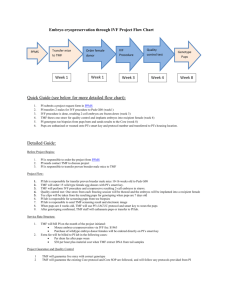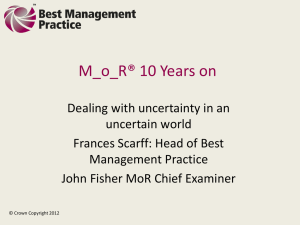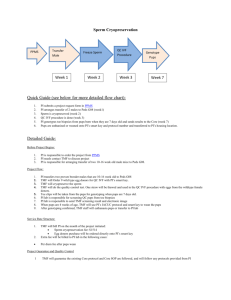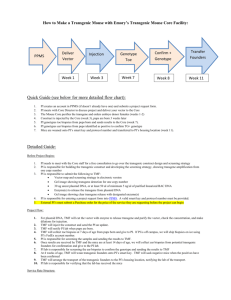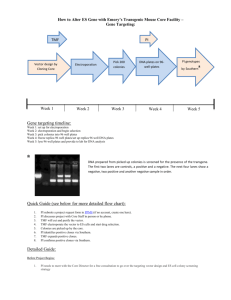Inspection Implications of Risk Based Approach
advertisement
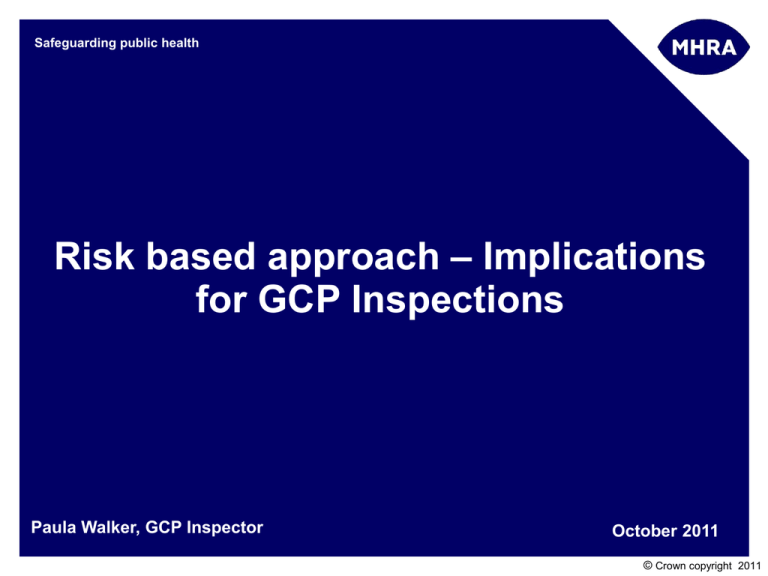
Safeguarding public health Risk based approach – Implications for GCP Inspections Paula Walker, GCP Inspector October 2011 © Crown copyright 2011 GCP Inspections & Risk Adaptation • The allocated trial category may impact on selection for inspection….unlikely that Type A trials will be inspected (unless trigger) due to low risk nature. • May be differences in documentation required and/or reviewed on inspection in the following main areas of trial conduct: IMP Implications Safety Reporting Implications Monitoring implications TMF review © Crown copyright 2011 IMP Implications • Adaptations to level of documentation required to verify IMP Administration. • Type A trial examples: IMP supplied via NHS prescription. Subject may be asked to keep a diary, or return used drug containers. This may eliminate need for detailed drug accountability log. Inpatient or vaccine trials commonly have IMP administered at the trial site by staff. Subjects then supervised. For Type A, sponsor could consider reduction in level of records required. That is, is it necessary to maintain : • A Pharmacy drug accountability log, • Plus another set of accountability worksheets for the product prepared in an aseptic unit by pharmacy. • Plus administration on an inpatient drug chart and an infusion chart (if applicable). © Crown copyright 2011 Safety Reporting Implications • • • • Type A may have reduction in SAEs requiring reporting. Protocol may define certain events as not needing immediate reporting (despite meeting SAE definition) e.g. trial endpoints or disease defining events. Must be approved! Could be covered in Safety Monitoring Plan submitted with CTA. Case: Trial investigating IMP safety in pregnant women. During trial, all women would be hospitalised at labour. Standard SAE definitions would result in all participants having an SAE. Protocol could define admission for normal labour as not requiring an SAE report. Same could apply to standard expected side-effects of chemo in oncology trials, which may not require SAE reports (unless frequency or severity is unusual). • Such SARs would still need reporting in annual DSURs. © Crown copyright 2011 Monitoring Implications • Risk-adaptive approach enables sponsor to conduct risk assessment prior to trial start to determine level/ type of monitoring. • Monitoring can take many forms: traditional on-site monitoring; central and statistical monitoring; peer review; trial steering committees and data monitoring committees, other remote activities (such as telephone calls, selfassessment/status or progress reports etc.) • Once optimal monitoring strategy has been decided, should be documented plan with clear documentation of: Type & frequency of monitoring Responsibilities Escalation process (e.g. if central monitoring, what triggers will be utilised for escalation to on-site visits) © Crown copyright 2011 For Reference… Central Monitoring Pro’s Con’s On-Site Monitoring Pro’s Con’s Automatic data checks Can only see data that’s Early detection of can identify issues with captured on CRFs, may protocol deviations and plausibility or consistency not identify other protocol violations deviations/violations Early identification of Won’t identify unreported Ongoing training sites not AE/SAEs/SUSARs completing/submitting CRFs/data Statistical monitoring can Lose the personal touch Verifying existence of identify site outliers, and of face to face contact patients conspicuous data patterns with sites and trends Early safety signal More motivational detection (i.e. increase of values close to defined limits etc.) More contactable by sites, as not “out on the road” More personal service with face to face interaction More cost effective Assess information not captured on CRFs (SDV) Time consuming Visiting sites means more travel, therefore unable to be contacted when “out on the road” May not identify trends and outliers across the study (as too close to the data) •Expensive © Crown copyright 2011 TMF Implications Type A or B trials are likely to have TMF documentation adaptations, essentially less documentation may be needed. For example: IMP Accountability documentation. Temperature (T) records are usually needed for IMP storage, however: • Unlicensed product used in Type C trial may be unstable outside particular T. range +/or have limited stability data +/or short shelf life. • T records may be irrelevant in Type A trials where IMP is marketed, used as per normal clinical practice, as storage arrangements are deemed appropriate standard practice (no additional requirements for trial purposes). © Crown copyright 2011 TMF Continued Evidence of Laboratory Quality Standards • Type C trial: a CRO lab may be used for drug sample analysis. Accreditation certificates would be appropriate. • Type A trial: if hospital lab used for haematology/ biochemistry analysis (as per normal clinical practice) supply of CPA certificates in TMF adds no value in terms of risk to patient safety or data quality. Plus, as labs require evidence of standards for normal clinical practice, such documentation could be made available upon request if necessary. © Crown copyright 2011 TMF Summary • GCP inspectors will take a pragmatic approach to the TMF content for Type A/ B trials. • Recommended approach for sponsors and PIs regarding TMF checklists: Is the document needed based on trial process to be used i.e. don’t include if it doesn’t apply! Is the information already available elsewhere in TMF? Does the document add value in showing quality of the trial conduct? Does having this document in the TMF matter for meeting trial objectives ? © Crown copyright 2011 Development of guidance •Risk adaptation will impact on the way that the GCP principles are complied with. Inspectorate guidance to be produced (likely in Q&A format). •Aim is to develop guidance with commercial/ non-commercial researchers conducting risk adaptive trials, to include real examples that may be published and used. •Priority topic will be trial monitoring. Volunteer organisations requested to assist with guidance development. Aim is to have ~10 clinical trials as potential source of approaches/ documents. Volunteers requested! © Crown copyright 2011 Volunteer Criteria Sponsoring/managing UK trial with risk based monitoring approach (documented risk assessment +/or monitoring plan). Should not follow the ‘regular on-site monitoring visit' model i.e. should use central monitoring techniques. Willing for trial documentation to be potentially published as examples e.g. protocol summary, risk assessment, monitoring plan (can be anonymised). Organisations formally comparing monitoring approaches of particular interest. Small consultative group planned of stake holders conducting suitable trials, including individuals with direct experience of managing/monitoring trials outlined above. If you wish to help with the guidance, please contact at: GCP.Inspectors@mhra.gsi.gov.uk © Crown copyright 2011 Summary The aim of risk adaption is to reduce duplicated or costly processes that are surplus to requirement. The GCP Inspectorate is keen to work with both industry and non-commercial organisations to implement this proportionate approach, and reduce the burden while maintaining the quality of the trial conduct. © Crown copyright 2011





